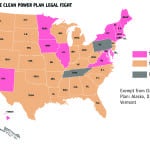A coalition of 22 states and seven local governments on Aug. 13 filed a lawsuit against the Environmental Protection Agency (EPA) over its Affordable Clean Energy (ACE) rule, which the Trump administration finalized in June to replace the Obama administration’s legacy Clean Power Plan (CPP).
Separately, 10 public interest groups filed a petition on Aug. 14 asking the U.S. Court of Appeals for the D.C. Circuit to overturn the ACE rule, claiming the EPA unlawfully repealed the CPP.
Like the CPP, the June 19-issued final ACE rule regulates greenhouse gases (GHGs), and it is founded on the agency’s 2009 Endangerment Finding. However, the ACE rule focuses on the nation’s 600 coal-fired units (at 300 facilities) and gives states leeway on deciding how they will meet “emission guidelines” stipulated in the rule.
The ACE rule also defines the “best system of emission reduction” (BSER) for GHG emissions from existing power plants as on-site, heat-rate efficiency improvements, and it outlines six “candidate technologies” and operating and maintenance practices that generators can use to improve heat rate—which is a measure of the amount of energy required to generate a unit of electricity. In the CPP, by comparison, the EPA determined that BSER should be comprised of three building blocks: increasing operational efficiency of coal plants; shifting power generation from coal to natural gas; and increasing power generation from renewables.
The 22 states suing the EPA over the ACE rule mostly have Democratic governors and/or attorneys general. The coalition includes: New York, California, Colorado, Connecticut, Delaware, Hawaii, Illinois, Maine, Maryland, Massachusetts, Michigan, Minnesota, New Jersey, New Mexico, North Carolina, Oregon, Pennsylvania, Rhode Island, Vermont, Virginia, Washington, Wisconsin, and the District of Columbia. The cities of Boulder, Colorado; Chicago; Los Angeles; New York City; Philadelphia, and South Miami also joined the suit.
In a statement, New York Attorney General Letitia James said the EPA’s rollback of limits established by the CPP will have “will have virtually no impact on these emissions, prolonging the nation’s reliance on polluting, expensive coal power plants and obstructing progress of states toward clean, renewable, and affordable electricity generation.” James pointed to the science behind climate change, noting: “Without significant course correction, we are careening towards a climate disaster.”
The the attorneys general of the 22 states note in their lawsuit that the EPA’s specified BSER will reduce emissions by only 0.7% more by 2030 than having no rule at all, citing materials the agency published with the final ACE rule, which suggest that compared to a no-CPP baseline, the ACE rule will reduce carbon dioxide emissions in 2030 by about 11 million short tons. However, the EPA says that if combined with emission reductions expected from industry trends, the ACE rule could reduce CO2 emissions from the electric sector by as much as 35% below 2005 levels in 2030.
“CO2 emissions in the power sector have steadily declined in recent years due to a range of factors including: market forces, technology improvements, and regulatory and other policy changes,” the agency said. “As a result, the industry has increased the use of natural gas and renewable energy sources. These trends have resulted in CO2 emission reductions even as the U.S. has sustained economic growth and job gains across the economy—and this has all happened without the CPP ever going into effect, due to the Supreme Court’s unprecedented stay of that rule in February 2016.”
The states also said, citing the EPA’s regulatory impact analysis for the repeal of the CPP, that under the ACE rule, emissions of of or more of three pollutants—CO2, nitrogen oxides (NOx), and sulfur dioxide (SO2)—will increase in 18 states in 2030 compared to a no-ACE rule scenario.
The groups that petitioned the D.C. Circuit for review of the EPA’s final action on ACE on Aug. 14 include: NRDC, Appalachian Mountain Club, Center for Biological Diversity, Clean Air Council, Clean Wisconsin, Conservation Law Foundation, Environmental Defense Fund, Environmental Law & Policy Center, Minnesota Center for Environmental Advocacy, and Sierra Club.
“With climate change impacts rising, and clean energy costs falling, EPA should be strengthening the Clean Power Plan, not scrapping it for a do-nothing dirty power scheme. We’re going to court today to stop Trump from destroying the clean air laws we have to protect Americans’ health and safety from the nation’s biggest climate polluters,” NRDC said in a statement.
Lissa Lynch, a staff attorney in NRDC’s Climate and Clean Energy program, suggested that the environmental groups may have a solid legal case. “The Trump EPA has now repealed the Clean Power Plan based on a newly-adopted interpretation of section 111(d), first advanced in former Administrator [Scott] Pruitt’s proposed CPP repeal, that limits the [BSER] to measures that can be ‘applied to an individual source.’ As we have repeatedly shown, the Clean Air Act sets no such restriction. The statutory language allows a more flexible conception of the [BSER] including the use of credits or trading to enable deeper reductions, as in the Clean Power Plan,” she said.
“The ACE Rule’s artificially constrained interpretation of section 111 is not compelled by the plain language of the Clean Air Act, nor is it even a reasonable construction of the statutory language.”
But at least one state—coal-rich West Virginia—is prepared to take a stand against the 22 states and environmental groups. West Virginia Attorney General Patrick Morrisey on Tuesday predicted the states’ lawsuit—which he called a “power grab”— “will ultimately fail at the Supreme Court.” The Clean Air Act, he argued, “was not written to compel one type of energy producer to cross-subsidize another. Neither it nor the Constitution allow the EPA to serve as a central energy planning authority.”
His points are central to legal arguments made by West Virginia in a series of legal challenges it mounted after the Obama administration finalized the CPP in August 2015. West Virginia’s concerns were echoed by 26 other states, several energy producers, utilities, and trade organizations, whose challenges were consolidated in the D.C. Circuit under the case, West Virginia, et. al. v. EPA (No. 15-1363).
That case remains in abeyance at the D.C. Circuit, though nearly all petitioners and petitioner-intervenors have recently filed motions to dismiss their challenges as moot, owing to the ACE rule’s publication in the Federal Register on July 8.
However, at least 17 states have claimed the EPA has taken “undue advantage” of the now two-year-long abeyance granted to the EPA by the federal court to allow it to review the rule, and they have urged the court to decide merits of the case, which it heard in the fall of 2016. In late July, respondents urged the court to deny or hold in abeyance petitions to moot the case, arguing they “premature.” The ACE rule does not become effective until Sept. 6, 2019, they noted.
—Sonal Patel is a POWER senior associate editor (@sonalcpatel, @POWERmagazine)










